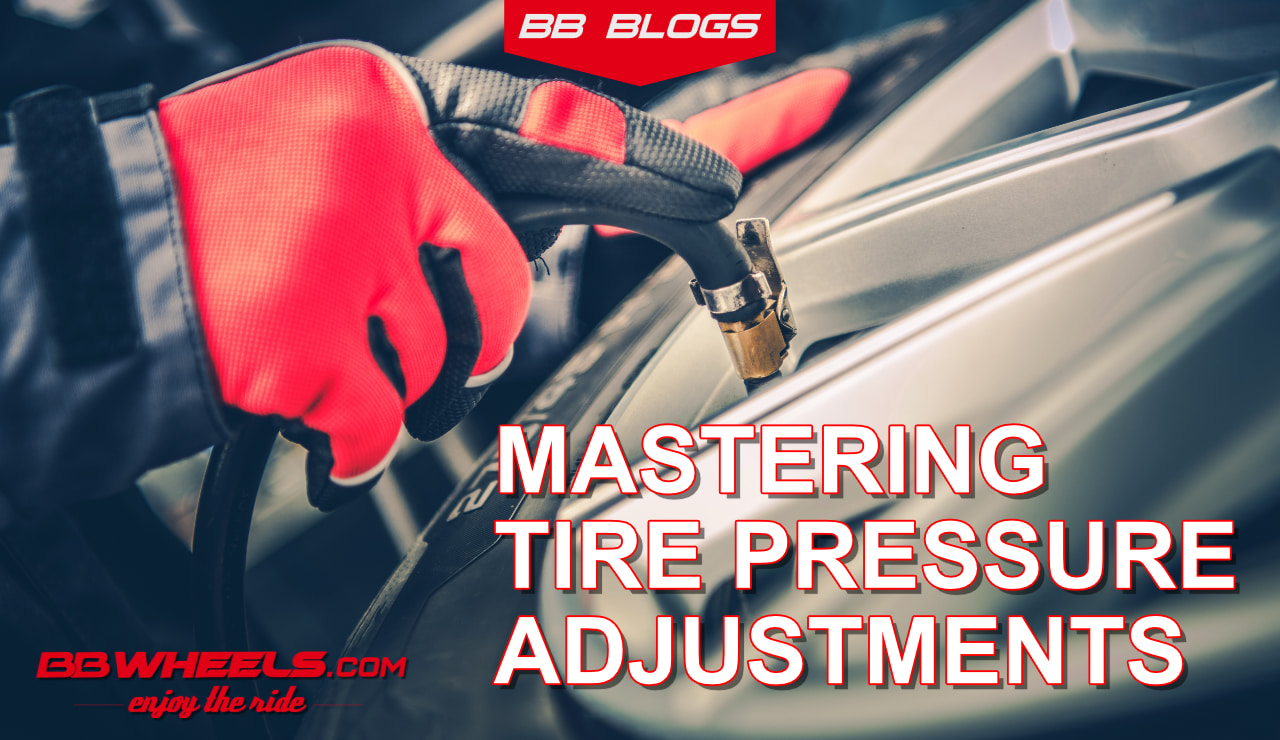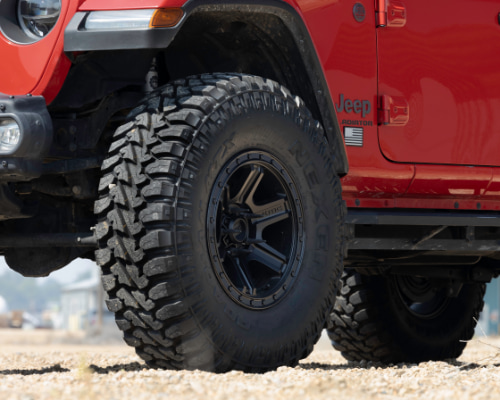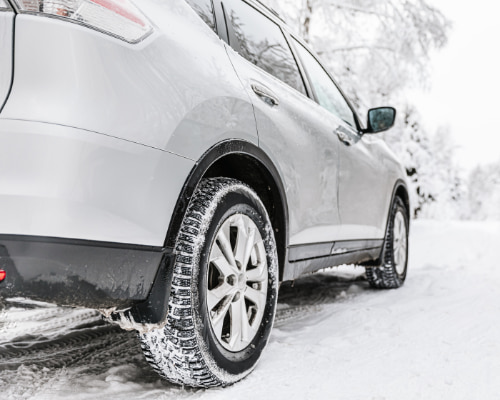Pressure Points: Mastering Tire PSI Adjustments
Posted by BB Wheels on 26th Oct 2023

Pressure Points: Mastering Tire PSI Adjustments
At BB Wheels, we understand the importance of maintaining the right tire pressure for your vehicle. Not only does it ensure a smooth and comfortable ride, but it also plays a crucial role in your vehicle's safety and fuel efficiency. But did you know that the optimal tire pressure can vary based on different scenarios? Whether you've upgraded to larger-than-OEM tires, are pulling a trailer, or are adapting to seasonal changes, adjusting your tire pressure accordingly is essential. In this guide, we'll delve into how to determine the best tire pressure for various situations.
1. Upgrading to Larger-than-OEM Tires:

Switching to larger tires can change the dynamics of your vehicle's performance. The increased surface area in contact with the road can affect weight distribution and may necessitate a tire pressure adjustment. Here are two reliable methods to ensure you're maintaining the correct inflation for your larger tires:
Load Inflation Table Method:
- Manufacturers often provide a load inflation table for their tires, which can be a valuable resource.
- Start by having your vehicle weighed during its typical usage. Many truck stops offer this service.
- Once you have the weight, refer to the specific load inflation table for your tire model. Match your vehicle's weight to find the recommended tire pressure.
Tire Chalk Test:
- This is a practical and visual method to gauge the right inflation.
- Begin by drawing a chalk line across the tread of your tire.
- Drive a short distance on a flat road.
- Examine the chalk line post-drive. An evenly worn line indicates optimal pressure. If the center is more worn, your tire might be over-inflated. Conversely, if the edges show more wear, it could be under-inflated. Make the necessary adjustments and repeat the test until the wear is even across the chalk line.
Recommendation: While both methods are effective, it's a good practice to cross-check results for accuracy. Always monitor the tire's performance and wear pattern over time to ensure continued optimal pressure.
2. Pulling a Trailer:

Towing a trailer introduces a new set of dynamics to your vehicle's performance. The additional weight, especially on the rear tires, can significantly affect tire pressure, handling, braking, and overall safety. Here's what you need to know:
Understanding Tongue Weight:
The tongue weight is the weight that the trailer puts on the hitch of the towing vehicle. Ideally, it should be about 10-15% of the total trailer weight. Too much or too little tongue weight can cause the trailer to sway or the towing vehicle to understeer.
Dual Axle Trailers:
If you're towing a dual axle trailer, it's crucial to ensure that both sets of tires are inflated to the correct pressure. Uneven tire pressure can lead to uneven tire wear and can affect the stability of the trailer.
Increased Stopping Distance:
The added weight of a trailer means your vehicle will require a longer distance to come to a complete stop. Ensuring your tires are at the optimal pressure can help in reducing the stopping distance.
Sidewall Flexing:
Under-inflated tires can flex more on the sidewalls, especially with the added weight of a trailer. This can lead to increased tire wear, reduced fuel efficiency, and can affect the handling of the vehicle.
Recommendation:
- Increase the tire pressure by 2-4 psi when towing, especially for long distances or with heavy loads. However, never exceed the maximum inflation pressure listed on the tire's sidewall.
- Always refer to the vehicle's owner manual or consult with a tire expert for specific recommendations based on the type and weight of the trailer you're towing.
- Regularly check the tire pressure on both the towing vehicle and the trailer, especially during long trips. Changes in altitude, ambient temperature, and load can affect tire pressure.
3. Seasonal Tire Pressure Adjustments:

Your vehicle's tire performance is intrinsically linked to tire pressure, which, in turn, is sensitive to seasonal temperature changes. It's not just the tire that supports your car's weight; it's the air pressure within it. This pressure is meticulously calibrated by manufacturers to strike a balance between optimal handling, fuel efficiency, and tire longevity.
Key Points to Remember:
- Temperature's Role: Air pressure in tires reacts directly to temperature changes. As temperatures rise, the air inside tires expands, potentially leading to over-inflation. Conversely, dropping temperatures can cause a decrease in tire pressure. A rule of thumb: a 10°F temperature shift can alter tire pressure by approximately 1 PSI.
- Seasonal Shifts: In regions like North America, where there's a significant temperature difference between summer and winter (around 50°F), this can translate to a tire pressure variation of 5 PSI or more across seasons, not accounting for other factors causing air loss.
- Driving Impact: Just a few miles of driving can heat up tires by about 20°F, which might increase tire pressure by around 2 PSI.
- TPMS Alerts: Vehicles equipped with a Tire Pressure Monitoring System (TPMS) often alert drivers to low tire pressure, especially when temperatures drop. However, those without TPMS might remain unaware of potential tire issues.
Recommendation:
- Always adjust tire pressures when they are cold. If you've driven your vehicle, wait at least three hours before checking and adjusting the pressure.
- Use a high-quality tire gauge for consistent readings.
- If your vehicle has been sitting in direct sunlight, move it to a shaded area before checking the pressure, as the sun's rays can heat the tires and give a false reading.
- Regularly inspect tires for signs of wear, damage, or any objects embedded in the tread. All these can influence the tire's ability to maintain the correct pressure.
4. Off-Roading Adventures:

Navigating off-road terrains requires specific tire adjustments to optimize traction, performance, and safety. While tire pressure adjustments are essential for off-roading, it's crucial to understand that the following PSI guidelines are general and can vary based on numerous factors. Always monitor tire performance and adjust accordingly:
Sand and Dunes:
General PSI Recommendation: 12-15 PSI.
Lower pressures can help the tire "float" on sand, preventing the vehicle from sinking.
Rocky Trails:
General PSI Recommendation: 15-20 PSI.
This range allows the tire to wrap around rocks, offering enhanced grip and minimizing puncture risks.
Mud and Wet Surfaces:
General PSI Recommendation: 20-25 PSI.
A broader tread pattern can be beneficial in muddy conditions, helping to prevent the tire from getting stuck.
Gravel and Dirt Roads:
General PSI Recommendation: 25-30 PSI.
This offers a balance between traction and comfort on uneven surfaces.
Key Points to Remember:
- These are general guidelines, and optimal tire pressure can vary based on factors like vehicle weight, tire construction, and specific trail conditions.
- It's advisable to start at a higher pressure and gradually reduce it, monitoring the tire's performance until you achieve the desired results.
- Always ensure the tire pressure isn't so low that it risks unseating the tire bead from the wheel.
- After your off-road adventure, remember to reinflate your tires to the recommended pressure for regular driving.
Recommendation:
For a successful off-roading experience, always carry a reliable tire pressure gauge and a portable air compressor. This ensures on-the-spot adjustments and the ability to reinflate tires for the journey home.
Final Thoughts:
Tire pressure plays a pivotal role in ensuring a vehicle's optimal performance, safety, and fuel efficiency. Whether you're upgrading to larger tires, towing a trailer, adapting to seasonal changes, or embarking on off-road adventures, understanding and adjusting your tire pressure is paramount. At BB Wheels, we're committed to guiding you through these adjustments, ensuring you get the best out of your tires in every scenario. Remember, these guidelines are starting points, and factors like vehicle weight, tire type, and specific conditions can influence the optimal pressure. Regularly checking and adjusting your tire pressure is the key to a safe and smooth driving experience.
Have questions or need expert advice on tire pressure or any other tire-related queries? Don't hesitate to reach out to us at 320-333-2155. At BB Wheels, we're always here to assist you on your journey to optimal driving.

